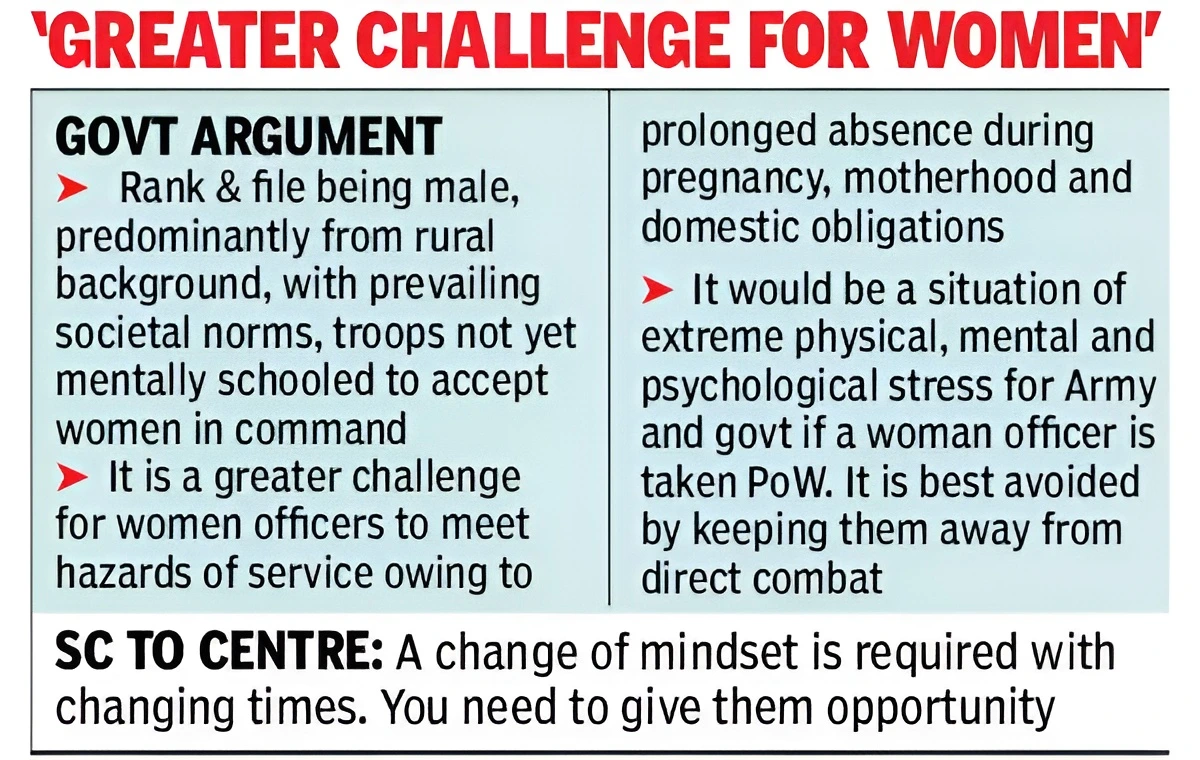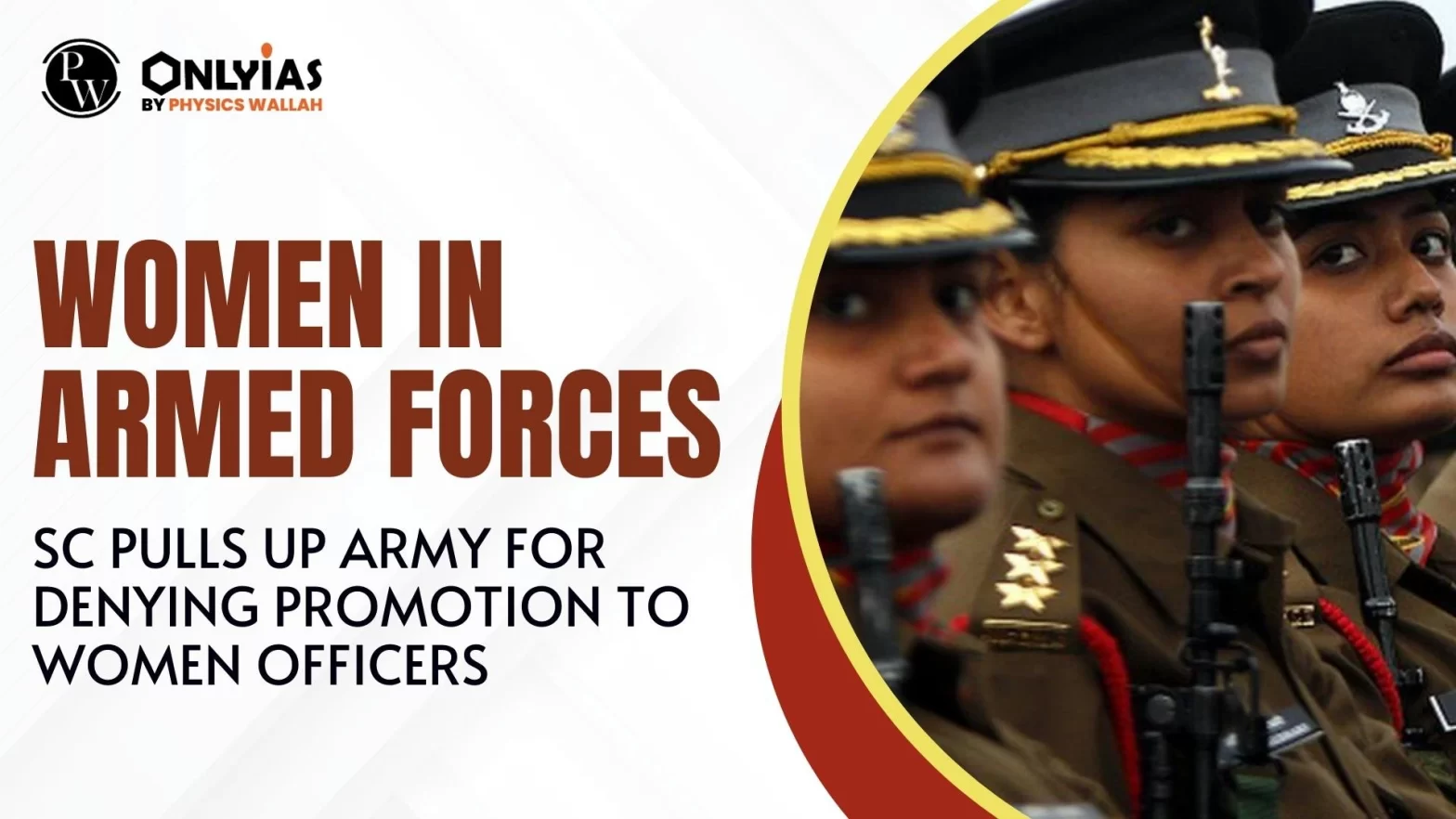Context:
- Recently, the Supreme Court said that the Army’s approach of denying women officers empanelment as colonel was “arbitrary”, and directed the authorities to reconvene the special selection board within a fortnight for their promotion.
Supreme Court Upholds Gender Equality: Rejects Vacancy Argument
- The Supreme Court rejected the argument of inadequate vacancies, noting that 108 out of 150 available vacancies had been filled.
- This decision is part of an ongoing battle for gender equality, following the court’s 2020 verdict granting permanent commission for women officers in the Indian Army and Navy.
Women In Armed Forces – Background
- 1992: The induction of women officers in the Indian Army begins. Recruits under the Women Special Entry Scheme (WSES) had a shorter pre-commission training period than their male counterparts who were commissioned under the Short Service Commission (SSC) scheme.
- Women officers were commissioned for a period of five years in specific streams such as the Army Education Corps, Corps of Signals, Intelligence Corps, and Corps of Engineers.
- 2003: A Public Interest Litigation (PIL) is filed before the Delhi High Court, seeking a permanent commission for women Short Service Commission (SSC) officers in the Army.
- 2006: The WSES scheme was replaced with the SSC scheme, which was extended to women officers.
- 2008: The Defence Ministry orders that PC would be granted prospectively to SSC women officers in the Judge Advocate General (JAG) department and the Army Education Corps (AEC).
- 2010: The Delhi High Court passes a judgment, granting PC at par with male SSC officers to women officers of the Air Force and Army on SSC who had sought permanent commission.
- 2019: The government passed an order in February 2019, granting PC to SSC women officers in eight streams of the Army, in addition to the JAG and AEC.
- However, these women officers would not be offered any command appointments and would serve only in staff posts.
- February 2020: The Supreme Court grants permanent commission to women officers with retrospective effect. This judgment places women officers in 10 streams of the Army on par with their male counterparts.
- The Court said that an absolute restriction on women seeking command appointments is against the constitutional right to equality under Article 14.2023: As of 2023, women are not eligible for service as combat troops in specialist forces such as the Parachute Regiment but they can join some of its non-combat wings like the signal corps, engineers, etc.
Women Participation in Agniveer Scheme:
- Women Agniveers: As a part of the Agnipath Scheme, women have been enrolled as Agniveers commencing from the first batch itself. They are subjected to the same training curriculum, professional courses, and retention criteria as compared to their male counterparts.
Know more about the Agnipath Defence Policy Reforms |
Current Status of Women in Armed Forces
- Indian Air Force (as of July 01, 2023):
- At present, women are serving in Officer’s cadre in the Indian Air Force (IAF).
- There are 1,654 women officers in the IAF, excluding Medical and Dental branches.Women officers hold key positions, including Commanding Officers in Combat Units, with gender-neutral rules for appointments.
- Indian Navy (as of July 26, 2023):
- Women officers are employed in officer ranks in the Indian Navy.
- There are 580 women officers in the Indian Navy, excluding Medical and Dental officers.
- Indian Army (as of January 01, 2023): The Army, being the largest of the three services, has the largest number of women officers at 1,733.
- Commission granted to Women Officers.
- Gender-neutral Career Progression policy implemented on 23.11.2021, ensuring equal opportunities for women officers in the Arms/Services.

Women in Peacekeeping Missions: The United Nations Security Council Resolution 1325, adopted in October 2000, reaffirmed “the important role of women in the prevention and resolution of conflicts and in peace-building.
- Civilian Peacekeepers
- Women serve in various civilian roles in UN peacekeeping missions, contributing to multiple aspects of peace and security.
- For example, the Electoral Officer in Mali: The UN Multidimensional Integrated Stabilization Mission in Mali (MINUSMA) and the members of its Electoral Affairs Section, have provided a wide range of support and assistance since the mission’s inception in 2013. Here, they are preparing materials ahead of Mali’s presidential election in July 2018
- Military Peacekeepers
- UN Peacekeeping boasts a growing number of women military personnel, who serve in leadership roles, military observation, staff positions, and as troops.
- For example, Peacekeepers on patrol in South Lebanon: Patrolling by the UN Interim Force in Lebanon (UNIFIL) has helped keep the peace in the south of the country. Here, a Spanish peacekeeper patrols at night along the Blue Line on the outskirts of Kafar Kela.
What are the challenges for women in armed forces?
- Meeting gender-neutral performance standards.
- Meeting rigorous physical, intellectual, and psychological criteria.
- Navigating a traditionally male-dominated environment for equal opportunities.
- Colonel DS Randhawa undertook a research project titled ‘Women Officers and Work Environment: Indian Perspective’.
- Key Findings: Married women officers with five to eight years of service experience found the presence of single women among male soldiers to be unsettling and perceived it as out of context.
- Sustaining continuous efforts for gender equality and performance excellence.
Physiological and Family Challenges for Women in Armed Forces
- Motherhood and Childcare: Balancing military service with the demands of pregnancy, motherhood, and childcare.
- Psychological Limitations: Overcoming psychological challenges that may arise due to the dual roles of a military officer and a mother.
- Separation and Transfers: Coping with frequent separations and transfers, which can impact children’s education and career opportunities for the spouse.
|
What are the challenges faced by the Indian Army?
- Change in Attitudes and Mindsets: The Supreme Court has highlighted the need for changing attitudes and mindsets in the armed forces to recognize the commitment to the values of the Constitution, ensuring equal opportunities for both men and women.
- Gender Quotas vs. Open Merit: Balancing gender quotas with open merit at the entry stage presents a challenge. The need for administrative reasons and infrastructure development may require the initial use of quotas.
- Example: The US military, which follows a merit-driven entry service in all arms including fighting arms and services, has 15-16 per cent women serving across all ranks.
- Addressing Sexual Assault and Harassment: The armed forces will face the challenge of addressing sexual assault and harassment of women within their ranks.
- The “warrior culture” and close proximity of men and women in the military can exacerbate this problem.
- For example: Despite Sweden’s reputation for promoting gender equality, an in-depth study of Swedish women officers found that many were subjected to intimidation, harassment, and threats from male officers.
- Infrastructure Development: Creating necessary gender-based infrastructure, especially in field areas, to accommodate mixed units/sub-units is a practical challenge.
- Physical Fitness Standards: The issue of setting appropriate physical fitness standards for women is a grey area, and it affects operational efficiency and career progression.
| Warrior Culture means to protect a particular culture or set of values that they think is under threat. |
Way Forward
- Education and Awareness: The armed forces should focus on education and awareness at all ranks to foster acceptance of gender integration and promote a culture of equality.
- Opportunities for a career in IAF are widely publicized. An opening has also been provided through NCC Special Entry for flying SSC (Women) from July 2017 onwards.
- ‘DISHA’ cell at Airforce HQ conducts various Induction Publicity programmes across the country related to the induction/ career of Officer Cadre in the IAF.
- Policy Framework: A comprehensive study should be conducted to frame a policy for entry, training, terms/conditions, and management of women in the armed forces, drawing from the experiences and best practices of modern militaries. In the Indian Navy, gender-neutral policies are present including spouse co-location, re-settlement postings, and compassionate grounds postings.
- For example: Opening key staff assignments in higher headquarters for women officers is crucial. Gaining experience in these roles will equip them to handle the challenges associated with unit command. This expertise is essential for preparing women officers for senior ranks.
- Gradual Transition: The armed forces should gradually transition towards a gender-neutral and merit-driven entry system, starting with gender quotas for administrative reasons and progressively increasing the proportion of women.
- Detailed Study on Sexual Assault: As women’s numbers in the armed forces increase, a detailed study should be conducted to address sexual assault and harassment issues. This should inform the development of policies, rules, regulations, and laws.
- Drawing inspiration from the United States: One of the first actions of US President Joe Biden was to order a “90-Day Independent Review Commission on Sexual Assault in the Military”. The Commission, chaired by Lynn Rosenthal, was charged with conducting “an independent, impartial assessment” of the military’s current treatment of sexual assault and sexual harassment.
- Review of Physical Fitness Standards: The armed forces should undertake a scientific study to review and potentially revise physical fitness standards for both men and women, ensuring operational efficiency and inclusivity.
- Utilizing Israel’s IDF as a Learning Experience:
- The Israel Defense Forces (IDF) is among the only armies in the world that conscript women into its ranks under a mandatory military draft law. As of 2021, women make up about 40% of the IDF’s conscript soldiers and about 25% of the officer corps.
Prominent Women in Armed Forces
- Gunjan Saxena: First woman to fly in a combat zone during the 1999 Kargil War.
- Padmavathy Bandopadhyay: First woman Air Marshal in the Indian Air Force (2004).
- Bhawana Kanth: First woman in the fighter stream of the Indian Air Force (2016).
- Tania Shergill: First woman Parade Adjutant for the Republic Day parade, leading an all-male contingent (2020).
Status of Women Armed Forces in Other Countries:
- Major countries like the United States, United Kingdom, and Russia, allow women to serve in command positions in their national armed forces.
|
Also Read: A Call for Comprehensive Police Reforms with a Focus on Women Police
Conclusion:
The journey toward gender equality in the Indian Armed Forces faces challenges, as highlighted by the recent Supreme Court directive, necessitating a comprehensive and gradual approach to policy reform, cultural change, and the recognition of women’s contributions.”
![]() 4 Nov 2023
4 Nov 2023

